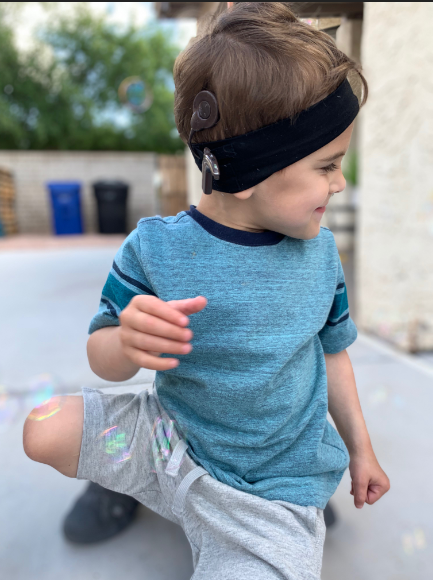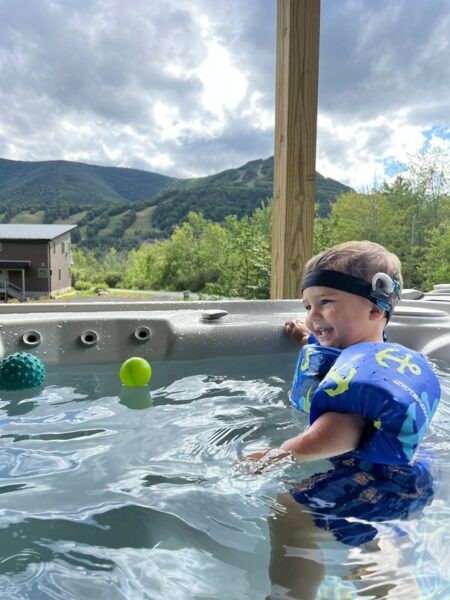For children with cochlear implants, it’s important they wear their sound processors as often as possible. But just how important is it?
A study1 conducted at the University of North Carolina at Chapel Hill found that for kids with cochlear implants, the more time they spent each day wearing their sound processor, the better their early language development assessments were one year after implantation. Of course, keeping your child’s sound processors on can be a challenge, so we provide tips and tricks to help you keep your child’s hearing devices on and working all day long.
Can wearing their sound processors more often really impact my child’s language development?
The University of North Carolina at Chapel Hill conducted a study analyzing the language progress of 37 children who were implanted with cochlear implants before the age of five. The purpose of the study was to determine the impact of device wear time on receptive and expressive spoken language development. Researchers used the datalogging capabilities of Cochlear™ sound processors to determine how much of each child’s waking hours were spent “in sound,” or with their sound processors on and working.
The results of the study indicated that kid’s “hearing hour percentage,” or HHP, was a predictor for receptive language outcomes one year after cochlear implant use. The more time children spent with their sound processors on and working, the better they scored on age-appropriate receptive language development assessments one year after cochlear implant activation. The authors of the study also recommended continued research to investigate whether hearing hour percentage is predictive of expressive language outcomes after a longer period of cochlear implant use.
It’s important for my child to wear their sound processor as often as possible. As a parent, what can I do to help?
Now that we’ve established how wearing their sound processor all the time can be impactful to your child’s hearing outcomes and language development, you might be asking: How do I help my child wear their sound processor more often? Especially for young, active, or strong-willed children, keeping their “ears on” can be quite a challenge. Here are our top tips and tricks for keeping your child’s hearing device on.
-
Use Cochlear accessories to keep your child in sound, no matter the activity.
For kids who like to run, jump, play, slide, swim, and move around throughout the day, keeping hearing devices in place can be tricky. Cochlear offers a variety of accessories designed specifically for active children, including:
- The Cochlear Pediatric Headband comes in two sizes and three colors to provide your child with a secure fit for their hearing device while they play sports or climb on the playground. There are pediatric headband options compatible with the behind-the-ear Cochlear Nucleus® 7 and Cochlear Nucleus 8 Sound Processors, as well as the off-the-ear Cochlear Kanso® 2 Sound Processor.
- The Cochlear Hugfit™ wraps all the way around the ear to help kids keep their device comfortably in place during even the most adventurous playdates. The Hugfit is available in three sizes for Nucleus 7 Sound Processor and Nucleus 8 Sound Processor.
- Stay water safe with Cochlear Aqua+ Kits234 that can help your child hear while they swim, splash, and enjoy spending time in the water. Cochlear Aqua+ Kits are available for a variety of sound processors.
- Safety cords, safety lines and clips can also offer you a little extra piece of mind while your child climbs, swings, leaps and plays. Take a look at all the options for keeping your child’s device in place.
-
Advocate for your child’s hearing with teachers and care providers.
One of the most important things you can do to make sure your child stays “in sound” throughout the day is to work closely with the other adults involved in their care, including their teachers, coaches, tutors, and daycare employees. Even if you are diligent about replacing your child’s sound processors any time they fall off or they’re removed, you can’t be with your child all the time. The other adults in your child’s life are an invaluable asset in keeping your child’s hearing device in place, and ultimately helping your child with their early language development. Cochlear offers a variety of resources to help you connect with your child’s teachers and provide the tools for your kid to succeed, including the Back to School Guide for Parents and Teachers. It covers school readiness at home, wireless accessories a teacher can use to help your child hear clearly, and practical tips and tricks to help your child stay “in sound” and engaged in the classroom.
-
Use tracking features to understand how much time your child spends wearing their sound processor.
Your child’s sound processor comes equipped with powerful data features that can help you track how often your child is wearing their sound processor. With certain devices and compatible smart phones, you can use the Nucleus Smart App®5 to access features of your child’s hearing device. By navigating to Hearing Tracker6, you can see how many times per day your child’s coil is removed from their implant and how many hours a day they spend in speech. This information can help you set goals for your child’s time in speech and help you make a plan to keep their sound processor on and working. If your child wears a sound processor of Nucleus 6 or later, your child’s audiologist may have access to even more data that can help you understand your child’s hearing journey.
-
Make hearing fun!
The most impactful way to keep your child’s hearing device on and working is to make hearing exciting, communicative, and fun. We offer resources to help you connect with your child and incorporate language development in everyday moments. No matter what age or stage in the hearing journey, your child can practice using listening and speaking to communicate with their family and friends. The lessons and activities in Sound Foundation for Babies, Sound Foundation for Toddlers, Sound Foundation for Children and LEAPing on with Language will help your child connect with sound through play with games and activities. The more fun your child has learning how to interact with the world through language, the easier it will be to keep their sound processors on and working.
Learn more about supporting your child throughout their cochlear implant journey.
- Gagnon, B. Erika, Eskridge, Hannah, Brown, D. Kevin Pediatric cochlear implant wear time and early language development. 2019 Sep 29; 1-6. Pediatric cochlear implant wear time and early language development: Cochlear Implants International: Vol 21, No 2 (tandfonline.com)
- The Kanso 2 Sound Processor is dust and water resistant to level of IP68 of the International Standard IEC60529. The Kanso 2 Sound Processor with Aqua+ is dust and water resistant to level of IP68 of the International Standard IEC60529. This water protection rating means that the sound processor with the Aqua+ can be continuously submerged under water to a depth of up to 3 meters (9 feet and 9 inches) for up to 2 hours. The Aqua+ accessory should be used when participating in prolonged water activities.
- The Nucleus 7 Sound Processor with Aqua+ is water resistant to level IP68 of the International Standard IEC60529. This water protection means that the sound processor with the Aqua+ can be continuously submerged under water to a depth of 3 meters (9 ft and 9 in) for up to 2 hours. This water protection only applies when you use a Cochlear Standard Rechargeable Battery Module or Cochlear Compact Rechargeable Battery Module. The Nucleus 7 Sound Processor is water-resistant to level IP57 of the International Standard IEC60529 without the Aqua+ accessory for the Nucleus 7 Sound Processor.
- The Cochlear Nucleus 8 Sound Processor is dust and water resistant to level IP68 of the International Standard IEC60529. The Nucleus 8 Sound Processor with Aqua+ is dust and water resistant to level of IP68 of the International Standard IEC60529 when you use a Cochlear Power Extend Rechargeable Battery Module or Cochlear Compact Rechargeable Battery Module. The Nucleus 8 Sound Processor with Aqua+ can be continuously submerged under water to a depth of up to 3 meters for up to 2 hours. The Aqua+ accessory should be used when participating in prolonged water activities. Refer to the relevant user guide for more information.
- The Cochlear Nucleus Smart App is available on App Store and Google Play. For compatibility information visit www.cochlear.com/compatibility
- The Cochlear Nucleus Smart App is available on App Store and Google Play. For compatibility information visit www.cochlear.com/compatibility


